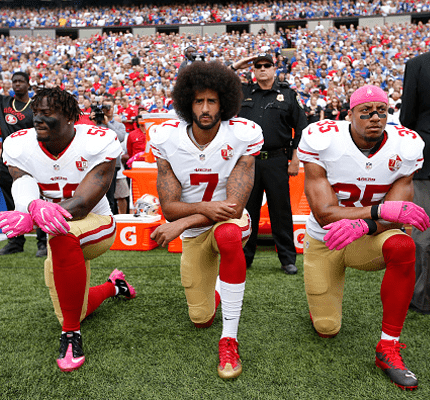
The NFL’s Response to the 2017 National Anthem Protests Shows How the Organization Protected Its Brand
In 2016, San Francisco 49ers backup quarterback Colin Kaepernick began kneeling during the national anthem at National Football League (NFL) games to protest systemic racism and police violence against Black Americans. In 2017, then-President Donald Trump called for Kaepernick to be fired for kneeling. This created a branding and marketing problem for the NFL as the league was forced to contend with players’ protests and the president’s public denunciation of players, while also working to protect the brand’s values. In a new article published in NCA’s Critical Studies in Media Communication, Jason Kido Lopez uses television broadcasts of NFL games, official statements, and social media posts to examine how the NFL addressed the challenge.
The NFL’s Brand
The branding of the NFL is not related solely to the NFL, which itself is a large entity, but also to the television networks that broadcast games, team social media posts, corporate partnerships, and online posts by individuals associated with the NFL, such as Commissioner Roger Goodell, players, and coaches. While these disparate actors may contribute to a unified picture of the NFL, some parties deviate from brand messaging at times. In 2017, this tension became clear when the national anthem became a way for players, coaches, and teams to make political statements on the field through mass action.
These protests conflicted with the NFL’s longstanding relationship with the U.S. military. Indeed, the national anthem itself became more popular after 9/11 as a means of demonstrating the league’s patriotism and support for the military. Lopez argues that because support for the military is nearly ubiquitous across major industries, including the NFL’s partners, this stance appears “apolitical” to many. In this context, when players stand for the anthem, it supports the brand’s broader messaging of support for the military. When players kneel, brand messaging becomes less clear. Kneeling during the anthem is read as support for Black Lives Matter and recognition of the violence that police have perpetrated in Black communities. Thus, Lopez writes, viewers may wonder where the NFL stands on the issues raised through anthem protests, which necessitates a response from the organization.
Activist Athletes and the National Anthem
On Friday, September 22, 2017, at a rally in Alabama, former President Trump stated that any athlete who knelt during the national anthem was a “son of a bitch” and called for them to be fired. The 15 football games that weekend presented the opportunity for fans to gauge how the NFL would respond to player protests.
Many players engaged in individual actions, including standing with a raised fist or kneeling. However, some teams also engaged in mass actions together. For example, some teams linked arms as a show of unity. In London, most of the players from the Baltimore Ravens and Jacksonville Jaguars stood together with arms linked; management also joined in, with team owner and Trump supporter Shahid Khan linking arms with the players as well. According to Lopez, “this was the most common unified team reaction, with over half the teams doing so during the weekend.” In contrast, many players on other teams chose to stay in the locker room. Lopez argues that these combined efforts were perceived as though “large portions of the NFL were using the national anthem to speak out against Trump.”
NFL leadership, including Commissioner Roger Goodell and coaches, initially issued statements that confirmed support for player free speech and for the value of NFL teams in their communities. However, Lopez argues that these statements paradoxically served to make the actions of specific players invisible. That is, the statements defended all players, rather than those who had been called out by Trump. In addition, some of the statements did not address the reasons that players were kneeling. Instead, Lopez argues that statements focused on the players’ character. For example, Miami Dolphins owner Stephen Ross, said, “I know our players who kneeled … are smart young men of character who want to make our world a better place for everyone,” which did not directly address the issue being protested. Although Ross did mention law enforcement in the statement, Lopez notes that Ross emphasized “bring[ing] people together,” rather than protesting police violence against Black Americans. Other than this statement, mentions of law enforcement were generally rare.
Overall, Lopez argues that the NFL’s response to the protests focused on “common unity.” Rather than weighing in on issues related to social justice and racism that might have divided its fan base, the NFL sidestepped the issue to focus on something more agreeable. According to Lopez, “these maneuvers isolate[d] the NFL’s brand from the activists and their messages about police brutality and racism.” Furthermore, Lopez contends that this strategy emphasized that the NFL is an apolitical institution. This message was also directly communicated by some in the league. For example, Carolina Panthers owner Jerry Richardson stated, “[p]oliticizing the game is damaging and takes the focus off the greatness of the game itself and those who play it.”
Conclusion
In 2018, the NFL issued an official policy that requires players to stand for the anthem. Under the policy, players who kneel or sit during the anthem will be fined. Lopez argues that in light of this policy, the actions in 2017 “were not about protecting players’ characters or right to free speech, and they certainly weren’t about unjust policing; they were about insulating the NFL’s brand from the apparent threat that was supposed to blow over.” Lopez concludes that this case study demonstrates how brands neutralize athlete activism and silence concerns about racism.


